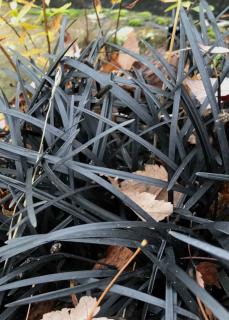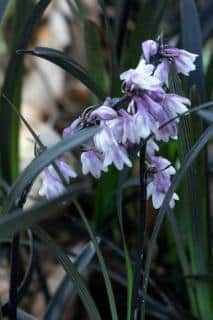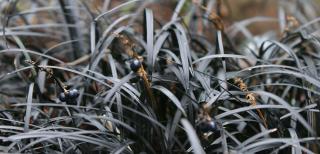

Ophiopogon planiscapsus ‘Nigrescens’ isn’t only original because of its shiny, long blackish leaves. It doubles its appeal with delicate pinkish-white flowers in summer.
Ophiopogon planiscapus, a few facts
Botanical name – Ophiopogon planiscapsus ‘Nigrescens’
Common name – Black Mondo grass or black lilyturf
Family – Liliaceae (lily family)
Type – rhizome perennial
Bearing – upright mound
Height – 6 to 10 inches (15 to 25 cm)
Planting density – 8 to 10 plants per sq. yard (m²)
Exposure – full sun to part sun
Soil: lots of humus, not chalky (no limestone) – Flowering: July-August

That’s why, it’s important to add compost or soil mix to your soil upon planting if it’s too poor. Take note of how heavy it seems (clay soil).
Planting dates can be any time in March or April. However, ideal timing is, as always, fall.

In order to sustain high levels of humus, spread a little soil mix around the base of the plant.
You might reach a point where your Ophiopogon starts spreading a bit too far because of its rhizomes. If that’s the case, all you need to do is circle around the clump with a sharpened square spade. After that, simply remove what’s on the outside of the circle.
Ophiopogon is vulnerable to cold frost spells. If there’s a risk of exposure to intense cold, cover the clumps with either dead leaves or straw hay. Once the heap is ready, tether it down with a weighted net.
Propagating your Ophiopogon is very simple:
When properly planted, O. planiscapsus “Nigrescens” isn’t particularly vulnerable to disease.
Pests are another matter. Young leaves are certainly a favorite of slugs.

The dark hue of its leafage makes playing with contrast easy and fun, all the while granting your garden an original eye-catcher.
Great plants to pair with your Ophiopogon ‘Nigrescens’ are light-colored leaf perennials and grasses such as hosta, Carex hachijoensis ‘Evergold’, Achillea umbellata, Liriope muscari, etc. Sounds crazy, but this black grass is also perfect for white gardens!
Add a few mineral ornaments or mineral mulch to the growing bed around your Ophiopogon planiscapsus. The black color highlights the harsh, pure touch of rock and gravel.